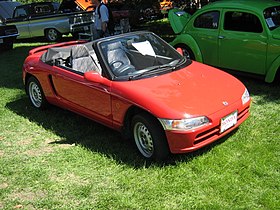
The Honda CR-X, originally launched as the Honda Ballade Sports CR-X in Japan, is a front-wheel-drive sport compact car manufactured by Honda from 1983 until 1991 with nearly 400,000 produced during this period. The first-generation CRX was marketed in some regions outside Japan as the Honda Civic CRX. Although there are many supposed definitions for the initialism CR-X, the most widely accepted is "Civic Renaissance Experimental".

The Nissan Maxima is a car manufactured and marketed by Nissan and offered as Nissan's flagship sedan primarily in North America, the Middle East, South Korea, and China—and currently in its eighth generation. Having debuted for model year 1982 as the Datsun Maxima, it replaced the earlier Datsun 810. The name Maxima dates to the 1981 model year when Datsun marketed the upscale 810 as the 810 Maxima in North America. Like the 810, early versions of the Maxima had their origins in the Datsun/Nissan Bluebird. It is renamed to Nissan Maxima when the Datsun brand was phased out for the 1985 model year.

The Honda Accord, also known as the Honda Inspire in Japan and China for certain generations, is a series of automobiles manufactured by Honda since 1976, best known for its four-door sedan variant, which has been one of the best-selling cars in the United States since 1989. The Accord nameplate has been applied to a variety of vehicles worldwide, including coupes, station wagons, hatchbacks and a Honda Crosstour crossover.

The Mitsubishi Lancer Evolution, popularly referred to as the 'Evo', is a sports sedan and rally car based on the Lancer that was manufactured by Japanese manufacturer Mitsubishi Motors from 1992 until 2016. There have been ten official versions to date, and the designation of each model is most commonly a Roman numeral. All generations use two-litre intercooled turbo inline four-cylinder engines and all-wheel drive systems.
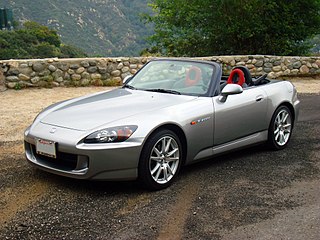
The Honda S2000 is a front-mid engine open top sports car that was manufactured by Japanese automobile manufacturer Honda, from 1999 until 2009. First shown as a concept car called the SSM at the Tokyo Motor Show in 1995, the production version was launched on April 15, 1999, to celebrate the company's 50th anniversary. The S2000 is named for its engine displacement of two litres, while "S" stood for "sports" carrying on in the tradition of the S500, S600, and S800 roadsters of the 1960s.

The Honda CR-X del Sol is a two-seater targa-top car manufactured by Honda from 1992 until 1998. Despite the body resemblance to a mid-engine car design, the del Sol is based on the front-engined Honda Civic platform and was the successor to the Honda CR-X.
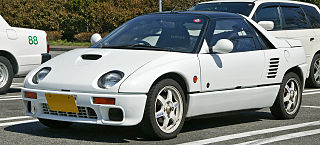
The Autozam AZ-1, known by the framecode PG6SA, is a mid-engined kei-class sports car, designed and manufactured by Mazda under its Autozam brand. Suzuki provided the engine as well as the inspiration for the design.

The Suzuki Cappuccino is a sports car produced by the Japanese company Suzuki from 1991 to 1998. It is a two-seater roadster with a detachable hardtop that is designed to meet Japanese kei car regulations.

The Chrysler PT Cruiser is a compact car that was built by the American company Chrysler from 2001 until 2010. Introduced as a five-door hatchback wagon, a two-door convertible variant was also made from 2005 until 2008.
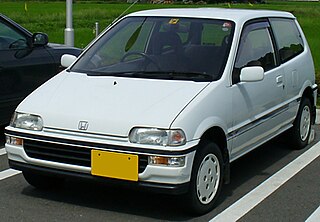
The Honda Today is a kei car produced by Japanese automaker Honda beginning in 1985. It was replaced by the Honda Life in 1998.
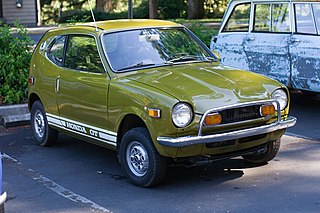
The Honda Z is a two-door hatchback kei car/city car manufactured and marketed by the Honda Motor Company, from 1970 until 1974. Exports mostly ended after 1972, when the domestic market models received redesigned pillarless bodywork.

The second generation Mercedes-Benz SLK, internally designated model R171, is a two-passenger, front-engine, rear-drive, retractable hardtop roadster, unveiled at the 74th Geneva International Motor Show—and manufactured and marketed for model years 2004–2010.

The Honda Life is an automobile nameplate that was used on various kei car/city cars produced by Honda: passenger cars, microvans, and kei trucks. The first series of the nameplate was built between 1971 and 1974, with the nameplate revived in 1997 and used until 2014. The Japanese-market Life has rarely been marketed outside Japan.

The Honda Civic Type R is a series of hot hatchback and sports sedan models based on the Civic, developed and produced by Honda since September 1997. The first Civic Type R was the third model to receive Honda's Type R badge. Type R versions of the Civic typically feature a lightened and stiffened body, specially tuned engine, and upgraded brakes and chassis, and are offered only in five- or six-speed manual transmission. Like other Type R models, red is used in the background of the Honda badge to distinguish it from other models.

The sixth-generation Honda Civic is an automobile produced by Honda from 1995 until 2000. It was introduced in 1995 with 3-door hatchback, 4-door sedan and 2-door coupe body styles, replicating its predecessor's lineup. The sixth-generation Civic offered two new 1.6-liter 4-cylinder engines and a new continuously variable transmission (CVT) on the HX model. The coupe and sedan are 2.3 in (58 mm) longer and the hatchback is 4.3 in (109 mm) longer than the previous-generation Civic. This was the last generation of Civic to have front double-wishbone suspension, as the succeeding seventh generation would change the front suspension to a MacPherson strut.

The E0 series is a three-cylinder gasoline engine developed and manufactured by Honda, with a total displacement of 656 cc. The engine is intended for kei car applications. The E05A and E07A were partially replaced by the Honda P engine but as of 2020 the E07Z engine still saw use in the Acty truck.

The Honda S660 is a sports car in the kei class manufactured by the Japanese company Honda from 2015 until 2022. It is a two-seater with a targa top and a transverse mid-engine and rear-wheel-drive layout. It is the successor to the Honda Beat, and the Honda S2000.

The first generation Honda NSX, marketed in North America and Hong Kong as the Acura NSX, is a 2-seater, mid-engine sports car that was manufactured by Honda in Japan from 1990 until 2005.
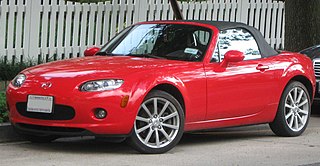
The Mazda MX-5 (NC) is the third generation of the Mazda MX-5 manufactured from 2005 to 2015. At its introduction in 2005, it won the Car of the Year Japan Award and made Car and Driver's 10Best list from 2006 to 2013.
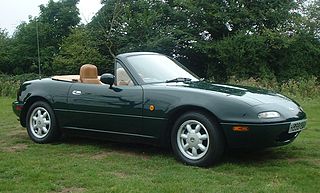
The Mazda MX-5 (NA) is the first generation of the Mazda MX-5 manufactured from 1989 to 1997. Inspired by the post-war era British sports cars, the MX-5 rejuvenated interest in roadsters after the demise of cars such as the MG B and Triumph Spitfire. Since its debut, the MX-5 has won numerous automotive awards and has become the world's best selling sports car.
